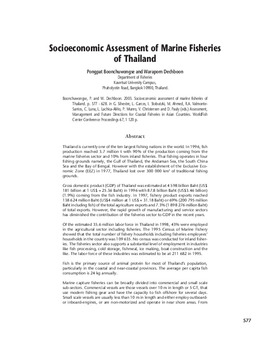Socioeconomic assessment of marine fisheries of Thailand
Abstract
Thailand is currently one of the ten largest fishing nations in the world. In 1996, fish production reached 3.7 million t with 90% of the production coming from the marine fisheries sector and 10% from inland fisheries. Thai fishing operates in four fishing grounds namely, the Gulf of Thailand, the Andaman Sea, the South China Sea and the Bay of Bengal. However with the establishment of the Exclusive Economic Zone (EEZ) in 1977, Thailand lost over 300 000 km2 of traditional fishing grounds. Gross domestic product (GDP) of Thailand was estimated at 4 598 billion Baht (US$ 181 billion at 1 US$ = 25.36 Baht) in 1996 with 87.8 billion Baht (US$3.46 billion) (1.9%) coming from the fish industry. In 1997, fishery product exports reached 138 624 million Baht (US$4 million at 1 US$ = 31.18 Baht) or 69% (200 795 million Baht including fish) of the total agriculture exports and 7.3% (1 898 276 million Baht) of total exports. However, the rapid growth of manufacturing and service sectors has diminished the contribution of the fisheries sector to GDP in the recent years. Of the estimated 35.6 million labor force in Thailand in 1998, 43% were employed in the agricultural sector including fisheries. The 1995 Census of Marine Fishery showed that the total number of fishery households including fisheries employees’ households in the country was 109 635. No census was conducted for inland fisheries. The fisheries sector also supports a substantial level of employment in industries like fish processing, cold storage, fishmeal, ice making, boat construction and the like. The labor force of these industries was estimated to be at 211 682 in 1995. Fish is the primary source of animal protein for most of Thailand’s population, particularly in the coastal and near-coastal provinces. The average per capita fish consumption is 24 kg annually. Marine capture fisheries can be broadly divided into commercial and small scale sub-sectors. Commercial vessels are those vessels over 10 m in length or 5 GT, that use modern fishing gear and have the capacity to fish offshore for several days. Small scale vessels are usually less than 10 m in length and either employ outboard- or inboard-engines, or are non-motorized and operate in near shore areas. From 1985 to 1995, the number of small scale fishing boats increased by 7.5%, while the commercial boats increased by 11%. One reason for the change has been the creation of a boat-tenure system within the commercial fishing sector, resulting in a decrease in the number of boats per household. The major fishing gear used by the small scale fishers are gillnets, small push nets, lift nets or other modern small scale gear, set traps, bagnets and other stationary gear in estuaries or protected inshore waters. In the fishing household of Songhkla Province, Southern Thailand, shrimp gillnets, cuttlefish trammel nets, Indo-Pacific mackerel gillnets, other gillnets and Acetes trawl nets are the major fishing gear. The fishers direct their effort towards high value species like shrimp, cuttlefish, pomfret fish and crabs, but they also obtain by-catch low value fish species. The most important determinant of profit for small scale fisheries is the interaction between types of gear and fishing ground. Commercial fishing vessels utilize otter trawls, pair trawls, beam trawls, push nets, purse seines and king mackerel gillnets as the major fishing gear. The analysis of investment, cost, revenue and return on demersal and pelagic fishing operations shows that (a) returns differ markedly among size of fishing boats and types of fishing gear; (b) ability to generate profit is greater in large fishing boats than small due to their higher ability to adjust to both economic (investment) and biological (fishing ground) changes; and (c) among the trawlers, medium and large boats can best adapt to maintain continuous profit, while for push nets, all size of boats show declining net profit. In pelagic fishing operations, purse seiners have been developed to make high profits and yield a higher return than trawlers and gillnet fishing operations. The Schaefer Model was applied to estimate the maximum sustainable yield (MSY) and maximum economic yield (MEY) for demersal fish and trash fish in the Gulf of Thailand. Results indicated that the present catch and the corresponding effort of demersal fishing in the Gulf of Thailand surpassed both MEY and MSY. In order to obtain the maximum net benefit in the long run, the present fishing effort of catching demersal fish must be reduced to about 50% of present levels. This would lead to the rehabilitation of marine resources and minimize the by-catch

